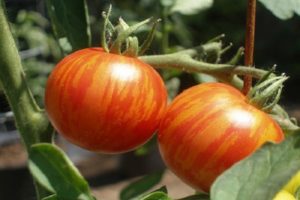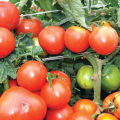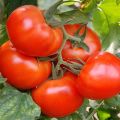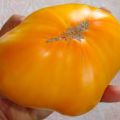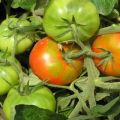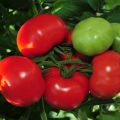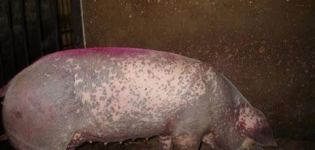Characteristics and description of the tomato variety King of the Early, its yield
Planting early varieties is a great solution to speed up your harvest. Tomato King of the Early is a variety that takes root well in central Russia. In greenhouse conditions, the Siberian climate tolerates well. It fully justifies its ambitious name, gives fruits of medium size with an individual, unique taste. A product of the selection of Russian scientists, it perfectly adapts to difficult environmental conditions.
Facts
Designed for open planting in Astrakhan, Kursk regions, Krasnodar Territory. The regions of the far north are not for this variety, but as a result of selection, the Siberian climate has become native to it.
The variety is able to withstand short-term frosts. The greenhouse conditions allow for a good harvest.
Among the main features are:
- ripe fruits have a characteristic red color;
- average weight 150 - 200 grams;
- multi-chamber - their number reaches 7;
- has a rounded shape;
- seed content - up to 5%.
When grown in extreme conditions, it has a peculiar Siberian accent. Fruits can be removed immature, which will extend the shelf life. Tomatoes ripen well in a cool, dark place.
The largest fruits are harvested after 80 - 90 days after planting. Their weight reaches up to 500 grams. The rest of the crop is medium-sized fruits. From one bush, you can collect up to 4 - 5 kg of wonderful tomatoes. For 1 sq. m usually accounts for 3 - 4 bushes. Average yield per 1 sq. m - up to 12 kg.
Taking into account the description of the variety and its features, it is possible to design the processing of fruits in advance. A vegetable garden and a garden can be kept on the same site, but the plants will bear fruit at different times. Horticultural crops are cultivated separately as they mature. The first tomatoes are convenient for making fresh salads or juice. The rest of the crop is suitable for canning.
Disadvantages and care
Since the selection of the first tomato seeds, the King of the Early Tomatoes have stood the test of time in many garden plots. The variety was registered in 2005. As the reviews of vegetable growers say, the culture stably bears fruit, but is sensitive to diseases and pests:

- has a weak immune system;
- prone to late blight;
- fights poorly with soil plants;
- requires constant attention.
But there are no perfect varieties. The characteristics of each culture depend on external factors. It is enough to create favorable conditions for the development of the plant, after which all the above disadvantages disappear:
- Tomatoes are light-loving plants. When planning plantings, it is necessary to place a garden and a vegetable garden in different areas, far from each other. Cherries or apple trees should not shade the beds. The culture is equally susceptible to both the eastern and western sun.
- Treatment with antibacterial drugs during the ripening period will help preserve the harvest. An amateur who planted a crop in an early time knows well when whiteflies, spider mites or slugs appear. Proper spraying will increase yields, reduce the risk of contamination of large areas, reduce or completely destroy the number of viable individuals that can harm the next season.
- Periodic ventilation of the soil when kept in greenhouse conditions will give the expected effect.
- Obligatory drying of the soil after watering. The culture gets used to the cycles of watering / drying / loosening, responds positively to changing conditions. The garden prevents this condition from being fulfilled, as it shades large areas.
- The variety is semi-determinate, the height of the bushes can reach one meter. Mandatory tying will prevent soil bacteria infection, provide access to sunlight, and ventilate the fruits.
- The root system of plants and fruit trees has significant differences. They work in different ways. Chemical processes of various contents and intensity take place here. The garden makes the soil looser, but releases organic substances into the soil, which will inhibit the vital activity of vegetable crops.
- In addition, the garden and vegetable garden have different irrigation regimes, soil fertilization schedules, antibacterial compositions.
- The favorable temperature for the development of tomatoes varies between +18 - 25 degrees. When it decreases, all vital processes slow down, which will affect the increase in the ripening time of fruits. An increase above the permissible value will lead to sterilization of the culture, the fruits will not set.

Considering the above points of plant life, you can get the maximum yield in a short time. This is especially true in areas of risky farming, short, cold summers.
Pest control
Pest and soil bacteria control can be carried out using traditional or modern methods. Their difference is fundamental, it all depends on the degree of defeat and the preferences of the gardener.
The nature of exposure to chemicals can be found in the instructions for use. Usually, their impact is more widespread, affects not only the vital activity of pests, but also the King of the Early tomatoes. In some cases, the fruits cannot be eaten after processing for a long time. This is due to the fact that chemicals affect metabolism and are in the sap of the plant that the pest eats.
Traditional methods are more loyal, scaring away insects that fly away to feed elsewhere. They do not harm nature. The grown and processed culture can be safely eaten. Separate methods help not only get rid of insects, but also enrich the soil with useful elements.
Interestingly, some plants also like to wash with soap. A soapy solution helps well against mites, at the same time it disinfects tops, fruits and partially the soil.
Slugs don't like ash. Among other things, ash is an excellent fertilizer, it contains a large amount of nitrogen. Will scare away pests, which will have a beneficial effect on growth. It is recommended to use a mixture of ash and ground pepper.
You can use traditional or modern methods against whitefly. A description of the action of the drugs can be found in the instructions for use. Fufanon, Ekamet, Decis, Embus, Inta-Vir are used. The list of drugs does not end there.
It should be remembered that after the initial treatment with chemical preparations, the eggs of the pest remain. After a while, you need to expect an invasion of hungry insects. Reprocessing required.For the normal cultivation of a crop, it is best to combine various methods, which will have a beneficial effect on growth, fruit formation, enrich the soil, and make a good start for the next season.
Traps
Special glue traps for insects in the summer can be seen in any store. They are popular due to their efficiency, lack of impact on the environment. Some types of traps contain special flavors that attract insects.

Previously, the chemical industry was not developed so strongly. Many gardeners simply coated the fabric with glue or honey and hung it over the plants. This method is effective when processing crops, keeping insects on the way to the coveted vase of jam. Produced under different names: Pheromone, Bona Forte, ARGUS.
Fumigators
Special devices that spray chemicals into the air. Effective when used in greenhouses, closed rooms. Available with removable plates or grout. The compounds are poisonous to humans, you cannot breathe such air. Destroys, repels various insects, has a wide spectrum of action.
Several naphthalene tablets are placed in a plastic bottle. Open the lid, distribute over the beds. The sun's rays heat the plastic. The pungent smell of naphthalene scares away pests, insects fly away to eat elsewhere.
Many gardeners have learned to grow an excellent harvest of tomatoes King of the early, taking into account the peculiarities of planting, growth, timing of harvest. Fighting the weak points of culture, timely care, combining the achievements of modern science and natural methods of fighting insects can work wonders. Gradually, invaluable experience is accumulating in caring for a new breeding species, which makes the Royal Family of Tomatoes a real favorite of gardeners and housewives.
